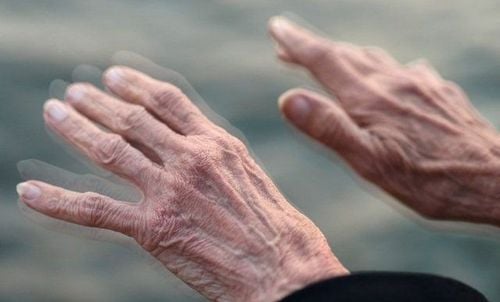This is an automatically translated article.
Article by Master, Doctor Vu Duy Dung - Department of General Internal Medicine - Vinmec Times City International Hospital
Parkinson's disease remains a clinical diagnosis. Asymmetric symptoms including resting tremors, bradykinesia, and muscle stiffness that respond well to dopaminergic therapy suggest the diagnosis.
1. Diagnosis of Parkinson's disease
Features that exclude a diagnosis of Parkinson's disease may include severe autonomic dysfunction, early onset hallucinations, dementia preceded by motor symptoms, and postural instability and freezing in first 3 years after diagnosis. The UK Parkinson's Disease Association Brain Bank Diagnostic Criteria is presented in Table 1-2 .
2. Clinical progression of Parkinson's disease
Parkinson's disease is a progressive neurodegenerative disease. The Movement Disorder Task Force recently identified three stages in early Parkinson's disease: (1) the preclinical phase, in which neurodegeneration begins but there are no clinical symptoms. sieve; (2) the signaling phase, in which symptoms are present but are not sufficient to diagnose Parkinson's disease; and (3) clinical phase in which Parkinson's symptoms are evident and recognizable.

Bệnh Parkinson là một bệnh thoái hóa thần kinh tiến triển
While it is difficult to accurately predict overall disease progression, motor fluctuations usually appear in patients within 5 to 10 years of diagnosis, while postural instability occurs after about 10 years. Patients often have an early “good” period after diagnosis, where they benefit from dopaminergic therapy. However, the disease eventually manifests as an erratic response to levodopa, motor complications and fluctuations, levodopa-induced dyskinesia, speech and swallowing deficits, icing, falls, and loss of balance. . Patients with younger onset of disease are more likely to have levodopa-induced dyskinesia and motor fluctuations, while patients with older onset of disease are more likely to have cognitive and autonomic disturbances. .
3. Differential diagnosis of Parkinson's disease
Diagnosis of Parkinson's disease can be complicated, and it is estimated that about 25% of patients are misdiagnosed with other diseases. The differential diagnosis of Parkinson's disease includes tremor syndromes, such as essential tremor, atypical Parkinson's syndromes (previously known as Parkinson-plus syndromes), as well as other tremor syndromes. Secondary Parkinsonism, and other cognitive disorders.
Probably the majority of the difficult differential diagnoses of Parkinson's disease are atypical Parkinson's syndromes. Red flag signs of atypical Parkinson's syndromes include premature slurred speech, loss of balance, absence of tremor (generally), symmetric symptoms (except for basal cortical degeneration), and poor response with levodopa. Atypical Parkinson's syndromes include progressive supranuclear palsy, basal cortical degeneration, diffuse Lewy body disease, and multiple system atrophy (cerebellar or Parkinsonian bodies, MSA-C and MSA-P, respectively). . Atypical Parkinson's syndromes often have dominant symptoms other than motor disturbances, such as autonomic dysfunction (MSA-C and MSA-P), supranuclear gaze palsy, and marked asymmetry/ dystonia of a limb with cortical signs (basal cortical degeneration).

Parkinson đặc trưng bởi các hội chứng run vô căn
|
Bước 1: Chẩn đoán Hội chứng Parkinson Chậm động (chậm khi khởi động vận động chủ động với giảm lũy tiến về tốc độ và biên độ các động tác lặp lại) Và ít nhất một trong các triệu chứng dưới đây: Cứng cơ Run khi nghỉ tần số 4-6 Hz Mất ổn định tư thế không phải do rối loạn chức năng thị giác, tiền đình, tiểu não, hoặc cảm giác bản thể. |
|
Bước 2: Tiêu chuẩn loại trừ bệnh Parkinson Tiền sử đột quỵ nhiều lần với tiến triển từng bước các triệu chứng Parkinson Tiền sử chấn thương đầu nhiều lần Tiền sử viêm não đã được chẩn đoán xác định Các cơn vận nhãn (thường là cơn trợn mắt) Khởi phát triệu chứng khi đang điều trị thuốc an thần kinh Có hơn một người họ hàng có triệu chứng tương tự Có giai đoạn thuyên giảm kéo dài Các triệu chứng giới hạn ở một bên sau 3 năm Liệt nhìn chằm chằm trên nhân Các dấu hiệu tiểu não Rối loạn thần kinh tự động nặng từ giai đoạn sớm Sa sút trí tuệ nặng từ sớm với rối loạn trí nhớ, ngôn ngữ, và hành động Dấu hiệu Babinski CT não có u não hoặc tràn dịch não thể lưu thông Không đáp ứng với liều cao của levodopa (sau khi đã loại trừ nguyên nhân do kém hấp thu) Phơi nhiễm với MPTP |
|
Bước 3: Tiêu chuẩn có khả năng hỗ trợ chẩn đoán xác định bệnh Parkinson Ba hoặc nhiều hơn để chẩn đoán xác định bệnh Parkinson Khởi phát một bên Có run khi nghỉ Bệnh tiến triển nặng dần Không đối xứng thời gian dài ở một bên cơ thể từ khi khởi phát Đáp ứng tốt (70-100%) với levodopa Múa giật nặng do levodopa Đáp ứng với levodopa từ 5 năm trở lên Quá trình diễn biến lâm sàng từ 10 năm trở lên |
CT = computed tomography; MPTP= 1-methyl-4-phenyl-1,2,3,6-tetrahydropyridine
Source:
Theresa A. Zesiewicz. Parkinson's Disease. Continuum (Minneap Minn) 2019;25(4, Movement Disorders): 896-918.
SEE MORE DOCUMENTS ON PARKINSON'S DISEASE BY DOCTOR VO DUONG:
Outline of Parkinson's disease Clinical symptoms of Parkinson's Disease Diagnosis of Parkinson's disease Causes, imaging and grading scales of Parkinson's disease Parkinson's Disease Drugs Parkinson's Disease Outpatient Treatment for Parkinson's Disease














